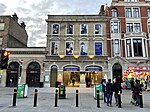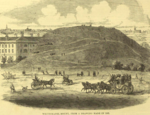Durward Street

Durward Street, formerly Buck's Row, is a street in Whitechapel, London. In the early morning of 31 August 1888, the body of Mary Ann Nichols ("Polly") was found on the pavement on the south side of Buck's Row. She is generally thought to have been the first victim of Jack the Ripper. As the case attracted much unwanted attention to the street, its name was changed that same year to Durward Street. The photograph shown here, taken in 2006, shows two features of Buck's Row that were present at the time of the murder. The tall building at the rear (west) is the former Buck's Row Board School, which can be seen in photographs of the street in 1888, now converted into residential flats and renamed "Trinity Hall". Extending east from it, along the south side of the street, is a low brick wall, also present in 1888. It was near the nearer corner of this wall that Polly Nichols's body was found. During the construction of Crossrail Durward Street has had a temporary entrance to the adjacent Whitechapel station.
Excerpt from the Wikipedia article Durward Street (License: CC BY-SA 3.0, Authors, Images).Durward Street
Brady Street, London Whitechapel
Geographical coordinates (GPS) Address Website Nearby Places Show on map
Geographical coordinates (GPS)
| Latitude | Longitude |
|---|---|
| N 51.5203 ° | E -0.0598 ° |
Address
Swanlea Secondary School
Brady Street 31
E1 5DJ London, Whitechapel
England, United Kingdom
Open on Google Maps








